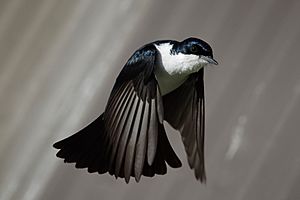Restless flycatcher facts for kids
Quick facts for kids Restless flycatcher |
|
|---|---|
 |
|
| Restless flycatcher in flight | |
| Conservation status | |
| Scientific classification | |
| Genus: |
Myiagra
|
| Species: |
inquieta
|
| Synonyms | |
|
|
The restless flycatcher (Myiagra inquieta) is a small to medium-sized bird found in Australia. It's also called the razor grinder or scissors grinder. This is because of the unique sound it makes. It belongs to a group of birds called passerines. These birds are known for their special foot structure, which helps them perch.
The restless flycatcher looks a bit like the willie wagtail. However, it has some clear differences. Birds found in New Guinea and northern Australia were once thought to be the same. Now, they are known as a different species called the paperbark flycatcher.
Contents
About the Restless Flycatcher
The restless flycatcher was first described in 1801. This was done by a bird expert named John Latham. He gave it the scientific name Turdus inquietus. The word inquietus comes from Latin and means 'restless'. This name fits the bird's active nature.
Birds from northern Australia and New Guinea are now seen as a separate species. They are called the paperbark flycatcher (Myiagra nana). These two species are very closely related.
What Does It Look Like?
The restless flycatcher is about 20 cm (8 inches) long. It has a shiny dark blue crest on its head. Its back is grey-blue, and its belly is white.
It looks similar to the willie wagtail. But you can tell them apart by a few things. The restless flycatcher does not have a black throat. It also has a crest on its head and no white eyebrow. Its body shape is also more slender.
Where Does It Live?
The restless flycatcher lives in eastern, south-eastern, and south-western Australia. You can also find it in Papua New Guinea. It lives from Cairns in Far North Queensland down to Victoria. It is also found in southern South Australia and south-west Western Australia.
During winter, many birds from the south move further north. This helps them find warmer places. Their homes are usually open forests and woodlands. They like areas near water, especially where river red gum trees grow. They also live in coastal areas and some towns.
Protecting the Restless Flycatcher
The restless flycatcher is listed as "least concern" by conservation groups. This means it is not in immediate danger of disappearing. However, its population is slowly decreasing. The exact number of these birds is not known. Efforts are being made to understand and protect them.
Behaviour and Life
Reproduction
The restless flycatcher builds a special nest. It is shaped like a cup. The nest is made from shredded bark and grasses. These materials are held together with spider webs. The inside of the nest is soft. It can be lined with soft bark, grasses, hair, or feathers.
The birds often decorate their nests. They use things like lichen, strips of bark, or spider egg sacs. Nests are usually built in the fork of a tree. These trees often have many leaves and are near water. Sometimes, nests can be very high up, even 20 metres (65 feet) above the ground.
Female restless flycatchers lay three eggs. The eggs are light-grey to white and look shiny. They have brown or dark spots, especially at the wider end.
Food and Feeding
The restless flycatcher eats mostly insects. It also eats other small creatures like spiders and centipedes. It hunts alone or in pairs.
This bird has a unique way of hunting. It often hovers in the air. Its head and tail point downwards as it looks for food. It picks insects off leaves while hovering. The restless flycatcher rarely goes to the ground to hunt. It prefers to catch insects from the middle parts of trees.
Images for kids
See also
 In Spanish: Monarca inquieto para niños
In Spanish: Monarca inquieto para niños



